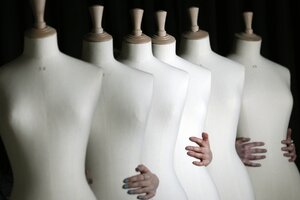How to ignore thin fashion models
A study in Europe links the fashion industry's use of super-thin models to the self-identity problems of many young women. The industry can do more to help girls find their true self-worth.

Fashion students grip plus-size mannequins during a photocall for their unveiling Jan. 16 at the Edinburgh College of Art in Scotland. The college will be the first in the United Kingdom to use plus-size mannequins for their students, ranging up to a size twenty.
David Moir/REUTERS
Much of public life these days is designed to remind individuals they can choose what to allow into their thinking. Movies, for example, come with ratings so people can decide not to watch violence or sex. Fewer schoolteachers give lectures and instead encourage pupils to sift through facts and competing ideas for themselves.
One of the most difficult challenges in helping people with such choices is the use of super-skinny models in fashion magazines and on the catwalk.
The destructive images of waifish women are closely followed by many young women who simply let others define a self-identity based on body shape – and in dress sizes 0 to 6. Even among 12-year-old girls who are underweight, two-thirds of them believe they are fat.
Now, a new study of nearly 3,000 young women in Europe finds that the fashion industry is a significant influence on a woman’s identity. The study found that countries with the highest rates of eating disorders such as anorexia are also places where young women generally worry the most about what they eat and have the highest circulation of fashion magazines.
“Self-image is correlated with body weight,” state economists Joan Costa-Font and Mireia Jofre-Bonet of the London School of Economics in their study, “Anorexia, Body Image and Peer Effects: Evidence from a Sample of European Women.”
The researchers call for urgent action to influence the fashion industry’s hold on young women. “Government intervention to adjust individual biases in self-image would be justified to curb the spread of a potential epidemic of food disorders,” they write.
Spain has tried to prevent the use of emaciated fashion models, with minimal effect on the industry. Since 2007, after the death of Brazilian model Ana Carolina Reston from anorexia, the American fashion industry set down voluntary standards to promote “wellness and a healthier working environment” for models.
This “health initiative” of the Council of Fashion Designers of America has been evolving, especially to make sure the industry doesn’t use girls under 16 for runway shows. The guidelines call on fashion executives to detect eating disorders in models and encourage them to get help or face not being hired. Tommy Hilfiger has even suggested models be licensed and registered to better address the problem.
Besides looking at fashion magazines, however, girls also turn to the Internet to follow super-thin models or to look for ways to lose weight. One popular website is Tumblr, which features individual blogs focused on images. In January, the company decided to ban blogs that promote “self-harm,” such as anorexia and bulimia.
All these efforts to help girls and young women gain control over their self-image may be driven by the fact that the weight disparity between models and average women is getting worse. According to PLUS Model Magazine, the average model now weighs 23 percent less than the average women. Twenty years ago, the figure was only 8 percent.
The industry must take better responsibility for the standard of physical appearance it promotes. It must help girls learn that their identity doesn’t depend on body shape. One way is to offer a diversity of sizes in models. That might encourage young women to know they have a choice rather than try to accept the perceptions of others that bone-showing thinness is the norm.

